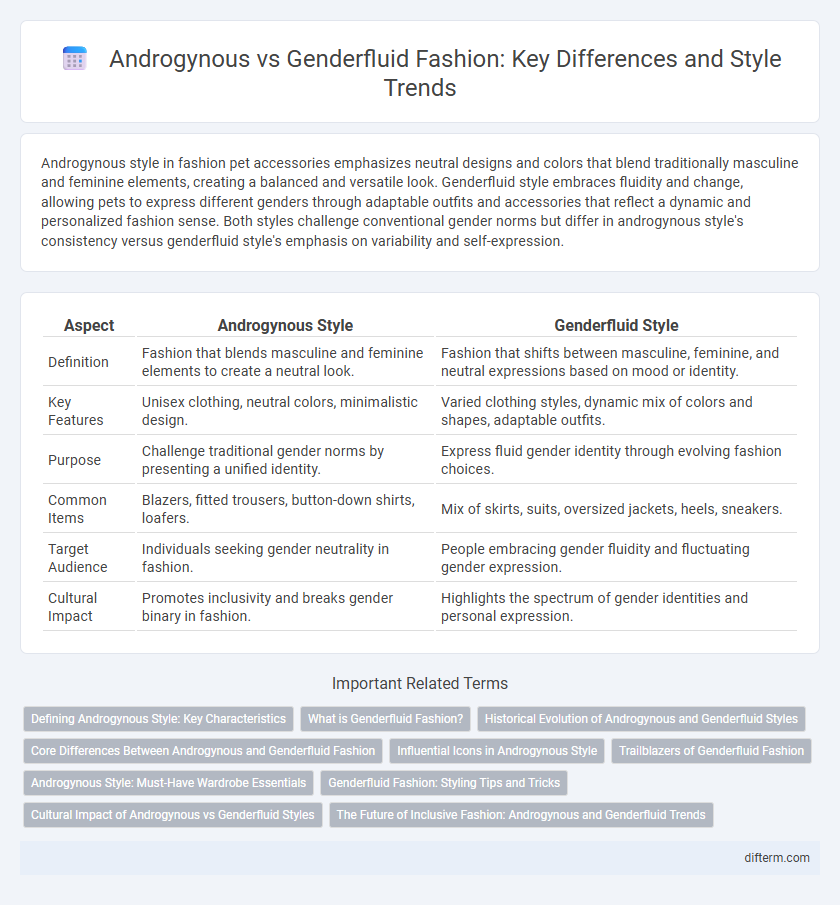Androgynous style in fashion pet accessories emphasizes neutral designs and colors that blend traditionally masculine and feminine elements, creating a balanced and versatile look. Genderfluid style embraces fluidity and change, allowing pets to express different genders through adaptable outfits and accessories that reflect a dynamic and personalized fashion sense. Both styles challenge conventional gender norms but differ in androgynous style's consistency versus genderfluid style's emphasis on variability and self-expression.
Table of Comparison
| Aspect | Androgynous Style | Genderfluid Style |
|---|---|---|
| Definition | Fashion that blends masculine and feminine elements to create a neutral look. | Fashion that shifts between masculine, feminine, and neutral expressions based on mood or identity. |
| Key Features | Unisex clothing, neutral colors, minimalistic design. | Varied clothing styles, dynamic mix of colors and shapes, adaptable outfits. |
| Purpose | Challenge traditional gender norms by presenting a unified identity. | Express fluid gender identity through evolving fashion choices. |
| Common Items | Blazers, fitted trousers, button-down shirts, loafers. | Mix of skirts, suits, oversized jackets, heels, sneakers. |
| Target Audience | Individuals seeking gender neutrality in fashion. | People embracing gender fluidity and fluctuating gender expression. |
| Cultural Impact | Promotes inclusivity and breaks gender binary in fashion. | Highlights the spectrum of gender identities and personal expression. |
Defining Androgynous Style: Key Characteristics
Androgynous style blends masculine and feminine elements to create a balanced, neutral aesthetic characterized by tailored silhouettes, minimalistic designs, and a muted color palette. Key characteristics include gender-neutral cuts, such as unstructured blazers, straight-leg trousers, and simple tees, prioritizing comfort and versatility over traditional gender norms. Fabrics often favor natural materials like cotton and linen, emphasizing functionality while challenging conventional gender-specific fashion boundaries.
What is Genderfluid Fashion?
Genderfluid fashion embraces a dynamic and flexible approach to clothing, allowing individuals to mix traditionally masculine and feminine elements without rigid gender boundaries. This style prioritizes personal expression and adaptability, reflecting the fluid nature of gender identity through versatile fabrics, colors, and silhouettes. Unlike androgynous fashion, which often blends male and female characteristics into a balanced look, genderfluid fashion actively shifts and changes according to the wearer's mood and identity.
Historical Evolution of Androgynous and Genderfluid Styles
Androgynous style emerged prominently in the early 20th century with icons like Marlene Dietrich challenging traditional gender norms through tailored suits and minimalist designs, reflecting a blend of masculine and feminine aesthetics. Genderfluid style, gaining visibility in the 21st century, emphasizes fluidity and changeability in fashion choices, rejecting fixed gender binaries influenced by contemporary discussions around gender identity and expression. Both styles have evolved through cultural shifts, with androgynous fashion rooted in historical rebellion against strict gender roles and genderfluid fashion representing a dynamic, inclusive approach to self-expression.
Core Differences Between Androgynous and Genderfluid Fashion
Androgynous fashion emphasizes a balanced blend of traditionally masculine and feminine elements, creating a neutral, cohesive look that minimizes gender distinctions. Genderfluid style, however, embraces a dynamic, ever-changing expression that shifts between masculine, feminine, and non-binary aesthetics, allowing for fluidity in clothing choices and identity representation. Core differences lie in the intent behind the styles: androgynous aims for ambiguity and blending, while genderfluid prioritizes versatility and personal evolution in fashion.
Influential Icons in Androgynous Style
Influential icons in androgynous style include David Bowie, known for blending masculine and feminine aesthetics, and Tilda Swinton, whose fashion choices challenge traditional gender norms with sharp tailoring and minimalist designs. These figures have shaped the androgynous fashion movement by promoting fluidity and self-expression through clothing that defies binary conventions. Their impact resonates in contemporary fashion, inspiring designers and consumers to embrace versatility and nonconformity in style.
Trailblazers of Genderfluid Fashion
Trailblazers of genderfluid fashion challenge traditional norms by embracing fluidity and self-expression beyond binary categories, influencing global fashion runways and streetwear culture alike. Designers like Harris Reed and brands such as Telfar have redefined clothing with inclusive silhouettes and versatile pieces that cater to diverse identities. Their innovative approach fosters visibility and acceptance, propelling genderfluid style to the forefront of contemporary fashion movements.
Androgynous Style: Must-Have Wardrobe Essentials
Androgynous style demands versatile wardrobe essentials that blur traditional gender lines, including tailored blazers, slim-fit trousers, and crisp white shirts. Neutral color palettes and minimalist designs emphasize clean silhouettes, making pieces like classic loafers and structured coats indispensable. Investing in high-quality basics that balance masculine and feminine elements ensures a cohesive, timeless androgynous look.
Genderfluid Fashion: Styling Tips and Tricks
Genderfluid fashion embraces versatility by blending traditionally masculine and feminine elements, allowing for dynamic self-expression that shifts with mood or identity. Key styling tips include layering diverse textures, mixing bold colors with neutral tones, and incorporating statement accessories to enhance fluidity and personalize each look. Emphasizing comfort and adaptability, genderfluid wardrobes often feature unisex pieces, oversized silhouettes, and gender-neutral footwear to create seamless transitions between styles.
Cultural Impact of Androgynous vs Genderfluid Styles
Androgynous style challenges traditional gender norms by blending masculine and feminine elements into a cohesive aesthetic, fostering greater acceptance of non-binary identities in mainstream fashion. Genderfluid style, characterized by its dynamic and evolving nature, reflects the fluidity of gender identity, encouraging cultural conversations about self-expression and inclusivity. Both styles significantly impact fashion by dismantling rigid gender binaries, promoting diversity, and influencing designers and consumers to embrace individuality and social progress.
The Future of Inclusive Fashion: Androgynous and Genderfluid Trends
Androgynous fashion emphasizes neutral silhouettes and minimalist designs that transcend traditional gender norms, creating versatile wardrobes accessible to all. Genderfluid style embraces dynamic self-expression, combining elements from various gender identities to reflect an individual's evolving sense of self. The future of inclusive fashion lies in blending these trends, promoting adaptive, non-binary clothing that challenges conventional categories and fosters greater diversity.
Androgynous style vs Genderfluid style Infographic

 difterm.com
difterm.com